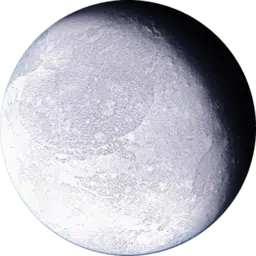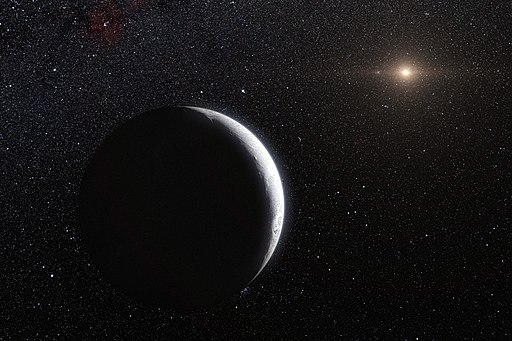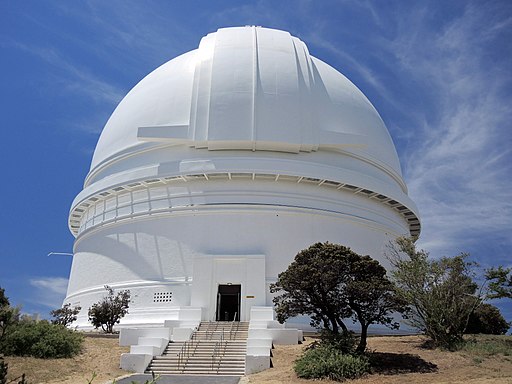
Named after the Greek goddess of chaos and discord, Eris is the second-largest dwarf planet in our solar system. At the time of Eris’ discovery, the planet and its moon were the most distant known objects in our solar system. This is just two of the facts about Eris that this article is all about.
Another of the facts about Eris is that it is three times Pluto’s distance from the Sun. In a cold region beyond Neptune, Eris is in a celestial region known as a shattered disk. The planet’s diameter is a little more than the width of half of the United States.
Facts about Eris include the fact that Eris is the tenth largest object to orbit our Sun. There are more facts about Eris below, like the fact that days on Eris last 25.9 hours. Years on Eris last 559 Earth days, so nearly one and a half Earth years is one year on Eris.
Everything there is about Eris facts is right here in this fantastic astronomy article. Read on to learn all about the massive dwarf planet known as Eris. Fascinating celestial bodies are wealths of information and Eris is no different.
Interesting Facts About Eris
Look no further for more interesting facts about Eris! Because of its distance from the Sun, the planet’s temperatures are extremely low. The minimum temperature on Eris is -243°C while the maximum temperature is 217°C. Gravity is also much lower here than on Earth. Earth’s gravity is at a brisk 9.8 m/s2 but Eris’ gravity is 0.82 m/s2.
One of the fun facts about Eris is that it’ll be closer to the Sun than Pluto in 800 years. Facts about Eris include the fact that it’s the largest object in our solar system not yet visited by spacecraft. Its atmosphere is also quite volatile. Facts about Eris the dwarf planet include the fact that Eris’ atmosphere is gaseous. However, once it’s farther away from the Sun, it freezes and falls like snow on Earth.
Another of the facts about dwarf planet Eris is that sunlight takes much longer to reach it. Sunlight takes 8 minutes to reach Earth and 9 hours to reach Eris. We’re talking about a force of nature that moves at about 299 million m/s. Really makes you think about how far away Eris is.
Let’s put a number to that thought. Given the 9 hours it takes for sunlight to reach it, Eris is 10.125 billion km from the Sun. Think about how long it takes you to walk a single kilometer, then multiply that by 10 billion.
Finally, Eris is also 27% more massive than Pluto. Despite this, both are technically just dwarf planets. Both orbit our Sun, though Eris was at some point recognized as our system’s tenth planet.
Eris’ Name
An intrepid team of astronomers first discovered Eris at Palomar Observatory. In January 2005, a team of astronomers were searching for objects in the outer solar system. After re-analyzing images taken in October 2003, they discovered Eris in January 2005. They completed their observations and calculations and brought those to IAU.
The story of how Eris got its name is inextricable from the time of its discovery. When it was first seen in January 2005, the discovery team at the time gave it the nickname Xena. This was in reference to a popular TV show then called Xena: Warrior Princess. The team included Mike Brown, Chad Trujillo, and David Rabinowitz.
At the time, they didn’t know whether Eris was a planet or a dwarf planet. So Eris would carry the name Xena until the official classification came out. It was just an informal nickname, however. A year later, Mike Brown would recommend the name Eris.
The reason for his suggestion was in conformity with the other planets in our solar system. Since Xena was also part of our solar system, he saw it as only fitting. Giving it a Greek or Roman deity’s name too was only right. So Xena’s name officially became Eris, the Greek goddess of chaos and strife.
Eris’ Moon
Some months after Eris’ discovery in 2005, the discovery team made another important find. Eris had a moon! Naming a planet’s moon was another important part of the discovery process with celestial bodies.
Since no official name came from NASA or them yet, the discovery team stuck with the Xena theme. The team gave the moon the name Gabrielle, after Xena’s sidekick in the TV show. IAU (International Astronomical Union) officially designated the planet as Eris. Brown suggested that they name the moon Dysnomia.
Again, we name celestial bodies after Greek deities. Dysnomia is the mythical daughter of Eris, who is also the Greek goddess of lawlessness. On top of the name conforming to the Greek pattern, he wanted to name the moon like his wife’s: Diane.
Far Away, Cold, and Dark
Far beyond the Kuiper belt, Eris is easily the largest member of the shattered disk. Small icy objects in both of these discs are the leftovers of planetary formation. In Eris’ scattered disk, objects have an extremely eccentric kind of orbit. They come as close as 30 AUs (astronomical units) to the Sun and as far as 110 AUs at the same time.
Because of this, Eris’ temperature is perpetually very low. We don’t mean an Arctic, wintery-kind of cold like you’d find in Siberia or our poles. The maximum temperature on Eris is -217°C. That’s hundreds of degrees colder than the most savage Arctic winter at -60°C.

Temperatures like that are the hottest you’ll ever find Eris. And that’s when it’s closest to the Sun in its orbit. That’s why Eris is a rocky planet with no life. It’s simply inhospitable by way of temperature.
You don’t even want to think about how cold and dark it is on Eris at its orbit’s end. At the end, the minimum temperature is at -243°C. This is when Eris is at its furthest from the sun. You could never grow anything remotely organic or needing sunlight there; it would freeze into ice instantly.
In that sense, you get some kind of idea of how the other Greek gods treat Eris. Nobody likes her; she only brings chaos and revels in it. Because of this, the other gods keep her away in cold and dark places like Tartarus.
Eccentric Orbit
Because of its very eccentric orbit, Eris’ orbit time is much longer than Earth’s. The average Earth year or orbit lasts 365 days, or what we call one Earth year. Eris’ orbit takes 559 Earth years to complete.
Think about it for a second. In the time it took for Christ to die and our time to happen, only 3-4 Eris orbits will happen. It takes mind-bogglingly long for Eris to complete a single orbit! When it was at its closest point to the sun (a perihelion) at 37 AU, it was 1698. It won’t be back there until the year 2256.
Fast Days
Despite the general pattern of other planets in our solar system, days on Eris are very nearly days on Earth. The average Earth day takes about 24 hours. Days are specifically when the Earth completes a full 360° turn. After all, we spin around the sun in our orbit, not the other way around.
Days in astronomy are sometimes known as rotations. One of the longest rotations in our solar system actually belongs to Venus. For context, a Venutian rotation takes 243 Earth days. That’s nearly a whole year just to have a single full day on Venus.
It’s even more fascinating that it seems to be reversely proportional. The faster the solar revolution, the slower the day is. However, that’s not exactly the case all the time. It depends on that planet’s specific orbit.
Because of its eccentric orbit, Eris’ days are basically Earth days. However, it would take 559 Earth years to make a full trip around the sun on Eris. For comparison, it would only take 225 days for Venus to make a full solar revolution.

